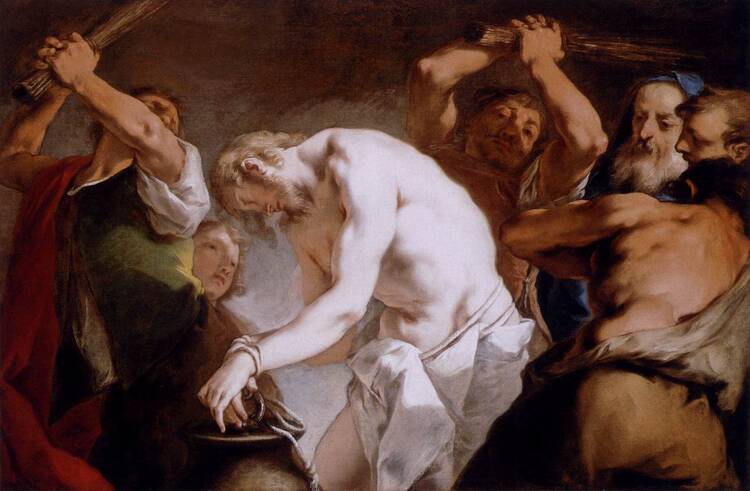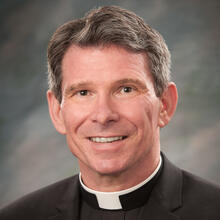A Homily for the Second Sunday of Lent
Readings: Genesis 22: 1-2, 9a, 10-13, 15-18 Romans 8: 31b-34 Mark 9:2-10
Those who have never questioned the Old Testament are those who have never read it, at least not all of it. Parts of it are difficult to reconcile with the notion of a loving God. For example, it demands death by stoning for transgressions such as stealing (Jos 7: 20-26) or breaking the Sabbath (Nm 15: 32-36). In Judges, to fulfill a vow made to God, Jephthah sacrifices his own daughter (11). The books of Joshua, Numbers and Deuteronomy depict genocide. In 2 Kings, God sends a bear to consume boys who mock the prophet Elisha (2: 23-24).
Most of these passages are not read in Christian worship. Abraham’s near sacrifice of Isaac on Mount Moriah is read—and always has been—even though the story is intended, at least initially, to inspire horror. In Hebrew, a three-time repetition creates a superlative, expressing the depth of Abraham’s sacrifice when he is commanded to kill:
Your son Isaac, your only one, whom you love (Gn 22:2).
The story remains troubling, but the early church could not help but read it as an enigma, one prefiguring Christ’s death. What God would not ultimately ask of us, God freely gives. The Father sacrifices his son Jesus, his only son, the one whom he loves.
The story is coupled with that of the Transfiguration, each an inversion of the other’s themes. The Mount Moriah story opens in darkness and ends in light: God tests Abraham’s faith but stops his sacrifice. The second story opens in light but points to darkness: Christ is transfigured on Mount Tabor, but only to prepare his disciples for his coming sacrifice on Calvary.
But whether we are pondering the Old or the New Testaments, we must understand that Scripture is not given to us to answer every conceivable question we might have. The Bible is not an occult oracle. Quite the opposite. God questions us in the Scriptures. What is it that we are meant to see? What is it that we cannot see? At least, not yet?
Simone Weil, the 20th-century Jewish philosopher and Christian catechumen (she deliberately prepared for a baptism she never received), suggested that evil is more easily recognized by the victim than the perpetrator.
The innocent victim who suffers knows the truth about his executioner; the executioner does not know it. The evil which the innocent victim feels in himself is in his executioner, but the executioner does not feel it. The innocent victim can only know the evil in the shape of suffering….It is the innocent victim who can feel hell (Gravity and Grace)
Evil blinds those who choose it. We do not see sin for what it is. Weil wrote: “When we do evil we do not know it, because evil flies from the light.” Only the one who stands outside of sin, the victim, can see evil for what it truly is. “We experience evil only by refusing to allow ourselves to do it, or, if we do it, by repenting of it.”
The executioner talks about the necessity of what he must do. His action is going to keep people safe; it will bring about true and lasting peace; it will create some utopia on earth. It is the innocent victim who suffers and who therefore sees the delusion in the executioner’s heart.
Indeed, it is innocent Isaac who senses something amiss on the way to Mount Moriah.
“Father!” he said.
“Yes, son,” he replied.
Isaac continued, “Here are the fire and the wood,
but where is the sheep for the burnt offering?” (Gn 22:7).
In like manner, Weil suggests that Jesus alone truly understands the evil that he sees, gazing down from Mount Tabor, gazing out upon Calvary coming.
The sin which we have in us emerges from us and spreads outside ourselves, setting up a contagion of sin. Thus, when we are in a temper, those around us grow angry. Or again, from a superior to an inferior: anger produces fear. But at the contact of a perfectly pure being there is a transmutation, and the sin becomes suffering. Such is the function of the just servant of Isaiah, the Lamb of God. Such is redemptive suffering. All the criminal vice of the Roman Empire ran up against the Christ and in him it became pure suffering.
We are not meant to encounter sacred Scripture and come away with smug answers. Scripture questions us; Scripture should challenge us. What are the evils I embrace by calling them necessary, good, evolutionary, regrettable yet required? Who are the victims of my evil? What can they see that I cannot?
It is only when we ask these questions of ourselves that we can repent of evil and begin to see it for what it is, to see it as only Christ, our sinless victim, saw it.








